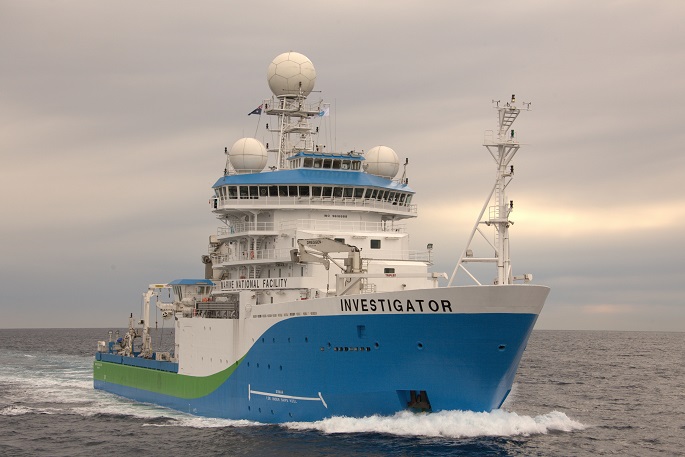CSIRO’s research vessel Investigator is on the longest voyage in its 10-year history to the Southern Ocean and sea-ice edge.
The aim of the 60-day voyage is to improve our ability to anticipate the impacts of future climate change. The vessel left on Friday.
The science teams on board, led by the Australian Antarctic Program Partnership and Australia’s national science agency, CSIRO, will search for climate clues between the deep ocean, up to six kilometres below the water surface, to low-lying clouds, 2km above in the atmosphere.
Co-Chief Scientist Dr Steve Rintoul, of CSIRO and AAPP, said the Southern Ocean takes up vast amounts of heat and carbon dioxide and acts as a handbrake on climate change, which means it has a profound influence on climate patterns in Australia and the rest of the globe.
“To anticipate how climate and sea level will change in the future, we need to understand how the Southern Ocean works and how sensitive it is to change,” says co-chief scientist Dr Rintoul.
“What’s amazing about the Southern Ocean is that everything is interconnected – we can’t hope to understand how the region influences climate unless we measure each piece and how it fits with the other parts of the system.”
The voyage, known as MISO for ‘Multidisciplinary Investigations of the Southern Ocean’)\ will explore how links between physics, biogeochemistry, plankton, aerosols, and clouds influence the Earth’s climate.
Changes in the Southern Ocean would have profound implications, influencing the rate of climate change, the productivity of the Antarctic ecosystem, and the future of the Antarctic Ice Sheet.
Changes in the Antarctic Ice Sheet, in turn, would affect the rate of sea level rise.
Recently published research has shown the “overturning circulation” of Antarctic waters driving global ocean currents may be slowing down, affecting the redistribution of heat, carbon and nutrients across the globe.
Co-chief scientist Dr Annie Foppert from the Australian Antarctic Program Partnership at the University of Tasmania says the meltwater from the Antarctic Ice sheet is reducing the amount of dense water sinking to the deep ocean around Antarctica, slowing ocean currents that control climate.
“Data collected on the MISO voyage will be compared to earlier measurements to track how the Southern Ocean is changing and what it means for climate and sea level rise,” says Dr Foppert.
“To track these changes in the deep ocean, we will deploy a dozen deep-diving robots.
“These new floats, able to collect measurements down to six kilometres below the sea surface, will allow us to track how the ocean is changing for the next five years by profiling the full depth of the ocean.
“Observing the deep ocean so regularly and over such large swaths was impossible before this new technology.”
The Southern Ocean takes up more of the heat and carbon added by human activities than any other latitude band on the earth.
“A key question is whether the Southern Ocean will continue to remove large amounts of our heat and carbon from the atmosphere, or will the Southern Ocean ‘sink’ become less effective as the climate warms,” says Dr Foppert.
“The Southern Ocean has essentially acted as a ‘climate shock absorber’ until now, but we need to probe the ocean depths to see if this will change in the future.”
Scientists onboard RV Investigator from the University of Tasmania and the Bureau of Meteorology will also study gases and particles released by tiny marine organisms called phytoplankton, grown in special aquariums mounted on the ship’s deck.
Gases and particles (or aerosols) released by the phytoplankton will be analysed to see how effectively they act as ‘seeds’ for new clouds.
Dr Marc Mallet, of the University of Tasmania, says understanding cloud formation in the southern hemisphere was a blind spot for climate science and model projections.
“This voyage will test the hypothesis that aerosols released by phytoplankton ’seed’ clouds and explain the unique properties of the Southern Ocean atmosphere,” says Dr Mallet.
“Improved understanding of cloud formation in the region will provide the foundation for more skilful weather and climate projections for Australia and the rest of the globe.”
The voyage will leave Hobart and sail south to the edge of the Antarctic ice travelling 9260 kilometres before returning to Fremantle in early March.
About the voyage
This voyage is supported by the Australian Antarctic Program Partnership (AAPP). The AAPP is funded by the Australian Government through the Antarctic Science Collaboration Initiative to better understand the role of the Antarctic region in the global climate system and the implications for marine ecosystems.
The AAPP is a 10-year program established in July 2019 and is led by the University of Tasmania (UTAS) with core partners the Australian Antarctic Division (AAD), CSIRO, and the Bureau of Meteorology (BoM).



2 comments
So 5 years of data
Posted on 09-01-2024 08:47 | By an_alias
What a farce, we will use 5 years of data to speculate and forecast the future. We have our conclusion already written, we just need the data we designed to get and wham bam you got it.
@an_alias
Posted on 09-01-2024 11:21 | By morepork
I think you are being overly cynical here. Science doesn't work like that; we have the capability to gather new information and they are doing so. I don't believe they have a pre-designed agenda. In the last 30 years we have begun to understand the interconnectedness of the world's ecology. It seems that the Southern Ocean figures in this and it would be advantageous to understand just HOW it does. The more knowledge and information we can gain, the better equipped we become to deal with the natural changes which are part of the background of climate change.
Leave a Comment
You must be logged in to make a comment.